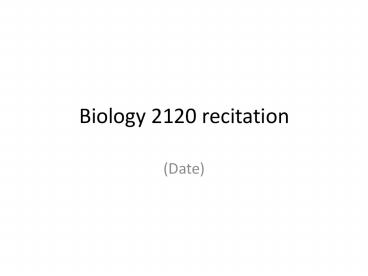Biology 2120 recitation - PowerPoint PPT Presentation
1 / 19
Title:
Biology 2120 recitation
Description:
[C] The outer membrane of the nuclear envelope is continuous with the endoplasmic ... [C] DNA replication requires an RNA primer Fig. 19-11 ... – PowerPoint PPT presentation
Number of Views:45
Avg rating:3.0/5.0
Title: Biology 2120 recitation
1
Biology 2120 recitation
- (Date)
2
Todays schedule
- Lecture review
- Quiz
- Review Quiz
3
- Lecture 9- Nuclear structure and DNA replication
- A The Big Picture
- A The nucleus contains and protects most of a
eukaryotic cell's DNA - B The nuclear envelope is a double membrane
structure - C The outer membrane of the nuclear envelope is
continuous with the endoplasmic reticulum Fig.
18-26 - C Nuclear pore complexes regulate molecular
traffic into and out of the nucleus Figs. 18-27,
18-28, 18-29 - B The interior of the nucleus is highly
organized and contains many subcompartments Fig.
18-32 - C The nucleolus contains DNA that encodes
ribosomal RNAs Fig. 18-33 - C The nuclear matrix helps to organize
chromosomes Fig. 18-31 - C DNA replication occurs at sites called
replication factories - C RNA polymerase complexes, and spliceosomes
are distinct structures within the nucleus
4
A DNA replication is a complex, tightly
regulated process Fig. 19-13 B DNA polymerases
are enzymes that replicate DNA C DNA
polymerases add new deoxyribonucleotides to the
3 end of a DNA strand Fig. 19-7 C DNA
polymerases proofread their work Fig. 19-10A
DNA replication is a complex, tightly regulated
process Fig. 19-13 B DNA replication is
semi-discontinuous Fig. 19-9 C DNA replication
begins at sites on chromosomes called origins of
replication Fig. 19-5 C Specialized proteins
unwind and separate the two strands during
replication to form a replication fork Origin
Replication Complex, MiniChromosome Maintenance
proteins Fig. 19-6, 19-12, 19-14 C DNA
replication requires an RNA primer Fig. 19-11 C
DNA ligases join fragments of single-stranded
DNA C Replication of DNA at the end of
chromosomes requires additional steps Fig. 19-15,
19-16 B Cells have two main DNA repair
mechanisms Fig. 19-17 C Excision systems remove
one strand of damaged DNA and replace it Fig.
19-18 C Recombination systems repair
large-scale DNA damage
5
A Mitosis Separates Replicated Chromosomes B
Mitosis is divided into stages Fig. 19-20 B
Prophase prepares the cell for division Fig.
19-20. 19-25 B Chromosomes attach to the
mitotic spindle during prometaphase C
Kinetochores attach chromosomes to the mitotic
spindle Fig. 19-22 B Arrival of the chromosomes
at the spindle equator signals the beginning of
metaphase Fig. 19-26 B Separation of chromatids
at the metaphase plate occurs during anaphase C
The onset of anaphase requires dissolving the
connections between sister chromatids condensins
and cohesins C Anaphase is subdivided into two
phases, anaphase A and anaphase B Fig. 19-24,
19-27 B Telophase begins to reverse the
structural rearrangements that occurred in
prophase B Cytokinesis completes mitosis by
partitioning the cytoplasm to form two new
daughter cells Fig. 19-28 C Fragmentation of
nonnuclear organelles ensures their equal
distribution in the daughter cells
6
Macromolecular Transport into and out of the
Nucleus
Figure 18-29
7
PYROPHOSPHATE
Figure 19-7
8
(No Transcript)
9
(No Transcript)
10
Arrangement of Proteins at the Replication Fork
Figure 19-14
11
The Extension of Telomeres by Telomerase
Figure 19-16c
12
Figure 19-25
13
Figure 19-24
14
Figure 19-25 Microtubule Polarity in the Mitotic
Spindle
Figure 19-27a Mitotic Motors
15
Quiz Time!
16
Research article
- Rationale
- Cancer cells have extra copies of some
advantageous genes, and these are in
extrachromosomal structures called double minutes
(pronounced my-noots) - Getting rid of double minutes will make cancer
cells more sensitive to chemotherapy drugs by
reducing the number of advantageous
genes/proteins - http//en.wikipedia.org/wiki/Double_minute
17
Research strategy
- Create a human colon cancer cell line that has
easy-to-identify genes that are present in double
minutes - Introduce three pieces of foreign DNA
- a piece of bacterial DNA encoding multiple copies
of a gene operator (lacO, a regulatory sequence)
this sequence will end up in the double minutes - a bacterial gene encoding a protein that binds to
lacO (lacR), fused to Green Fluorescent Protein
(easy to see with fluorescence microscope) - a piece of DNA containing sequences necessary to
create double minutes - The cells form lacO-containing double minutes
that are bound by GFP-tagged lacR protein
18
Research strategy
- Add hydroxurea to cells HU removes double
minutes by introducing double-stranded breaks in
DNA - Look for evidence of double stranded breaks by
immunofluorescence microscopy use a primary
antibody that binds to the phosphorylated form of
a histone (histone H2AX) - DATA Green fluorescence shows presence of double
minutes, phospho-H2AX (red), and position of all
DNA (blue)
19
Exercise form groups
- Translate the title
- Write out the hypothesis
- Identify three premises look in Figures 1, 2,
and 3 - Write out one logical argument containing at
least two of your premises - Does this argument support or disprove their
hypothesis?































